COVER STORY:
Continuity, Not Change: Obama in India
Amidst all the hoopla, U.S. President Barack Obama’s trip to the U.S. is less a pathbreaking trip rather than a more profound indicator of India’s economic heft in global politics — today the world’s largest superpower is wooing India as it eyes enormous possibility in better business ties, writes Siddharth Srivastava.
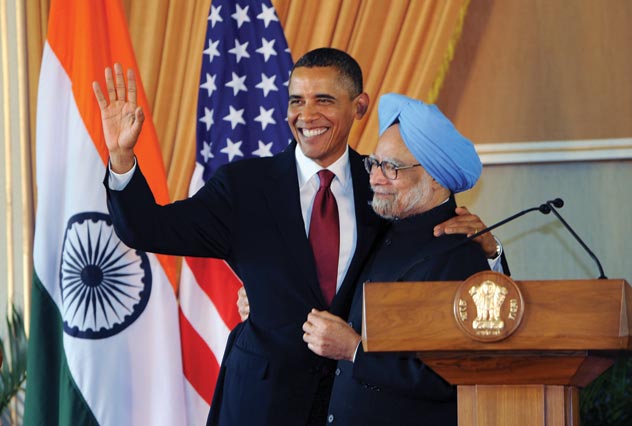
(Above): U.S. President Barack Obama (l) and Indian Prime Minister Manmohan Singh after a press conference at Hyderabad House in New Delhi. [Photo: PRESS INFORMATION BUREAU]
U.S. President Barack Obama’s visit to India was about continuity rather than change, of reinforcing a trend begun perhaps a decade back rather than being a pathbreaking one.
If there is any new beginning, it will perhaps be a new norm of American presidents, which may or may not include Obama again, who will mark their tenures with a mandatory visit or two to India – the essence of such high profile stops being business and tapping an emerging market as has happened with China.
With India, it extends to sectors such as defense, retail, financial services, power, nuclear energy, aviation and insurance. Specifics include Boeing contracts and Harley Davidson bikes.
Boeing, Lockheed Martin, GE, among others, have already set up shop in India. Walmart is set to follow soon.
The prospects of a strong Indian economy have been a game changer, prompting Obama, under pressure to create U.S. jobs, to describe the South Asian nation as having already emerged, which not only sounds good but is also terrific marketing to influence a customer.
In future, there are likely to be more such propositions. Indeed, by the standards of American presidential visits in India Obama spent quite a while here.
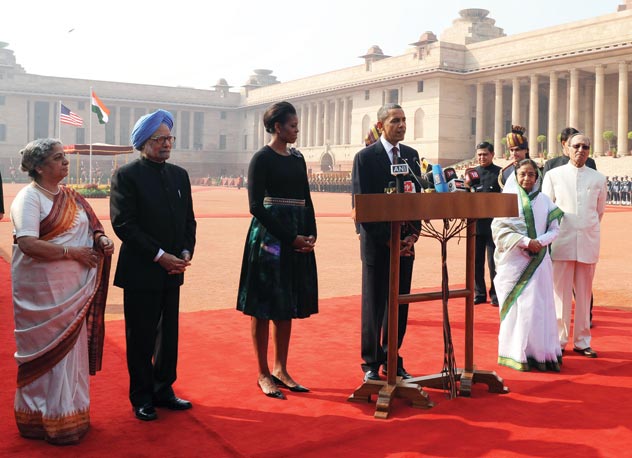
(Above): U.S. President Barack Obama interacting with the media as First Lady Michelle Obama (3rd from l), Indian President Pratibha Devisingh Patil (5th from l), and the Indian Prime Minister Manmohan Singh look on, at the ceremonial reception, at Rashtrapati Bhawan in New Delhi, Nov. 8. [Photo: PRESS INFORMATION BUREAU]
The Indian opportunity was perhaps first noticed by former U.S. President Bill Clinton and firmed up in American policy making structures by former President George W. Bush who pushed through the India-U.S. civil nuclear deal, despite global odds.
One crux of the Obama’s visit is that America now views India beyond the strategic prism of Cold War blocs, a potential ally in the war on terror and in handling Afghanistan and Taliban.
In the past India has had a relatively minor role in such aspects which is unlikely to change in the future.
For such matters America needs Pakistan much more in order to take on the proliferating Islamist infrastructure in the region.
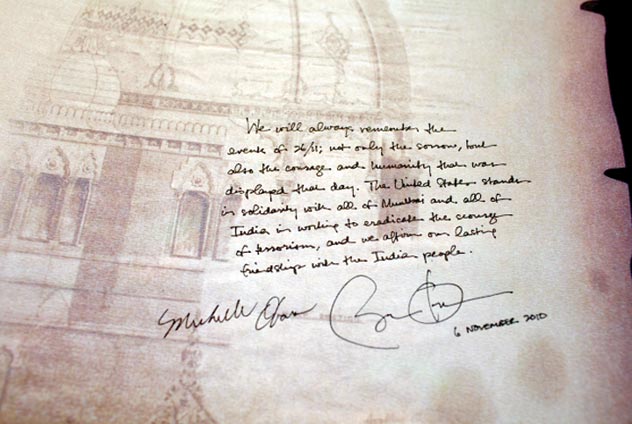
(Above): U.S. President Barack Obama and First Lady Michelle Obama signed a guest book at the memorial for the victims who were killed in the Nov. 26, 2008 terrorist attack at the Taj Mahal Palace and Tower Hotel in Mumbai, Nov. 6, 2010. [Photo: Pete Souza | White House]
Washington knows that it cannot successfully wage the war on terror without the Pakistan Army on its side, given the well-entrenched terror cadres in inhospitable locations and frontier regions.
Thus, the dollops of military aid to Pakistan will continue till the region heads to a modicum of stability, which will not happen very soon.
Pakistan lobbyists in Washington will seek a greater flow of aid money while American lobbyists in New Delhi will look for bigger business deals.
If there is a long-term American strategic interest in India, it has to do with China in order to balance out the power equations in the Asian region.
Yet in the last decade or so India’s position in American thinking has moved into a more serious level with weak strategic geo-political elements being substituted by deeper business meanings.
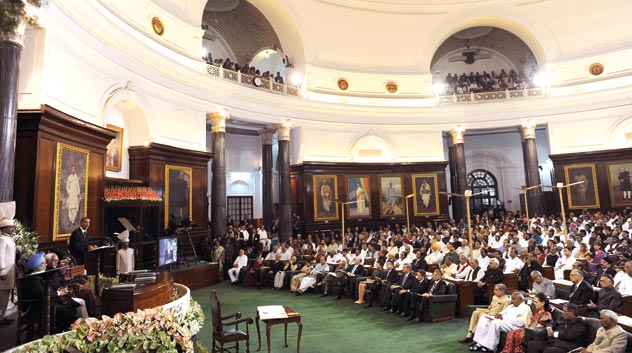
(Above): A wider view of U.S. President Barack Obama addressing the joint session of Parliament in the Central Hall of Parliament House in New Delhi Nov. 8. [Photo: PRESS INFORMATION BUREAU]
A bit of American diplomacy will try to influence Indian industry. American voices against outsourcing are likely to die down once the compulsions of domestic politics and recession wane, given U.S. business backing to moving operations to lower cost areas.
There will be efforts to sweeten the big India deals, given the competition from Europe, South East Asia and China, which has happened this time as well – high tech exports from America and backing for a permanent seat at the UN Security Council.
It should not be lost to anybody that Obama’s anti-outsourcing speeches have mostly been at election rallies.

(Above): U.S. First Lady Michelle Obama plays hopscotch at the “Make A Difference” (MAD) program at the University of Mumbai in Mumbai, Nov. 6. MAD volunteers use creative outlets, like a vocabulary-building hopscotch game to teach english to underprivileged children. [Photo: Chuck Kennedy | White House]
The American India interest runs much deeper than call centers and lower end jobs. There is a whole gamut of American manufacturing and service sectors that can win sizeable Indian contracts as evidenced by Reliance Power and Spice Jet contracts with U.S. firms.
Obama has firmed up the business trends further.
Mention of Bangalore may not excite Obama too much right now given his mid-term election reverses.
But his stop at commercial capital Mumbai before heading to Delhi was not only about a message against terror. It was also an attempt to bring to the forefront meetings with business CEOs and highlight potential directions of Indo-U.S. relations.
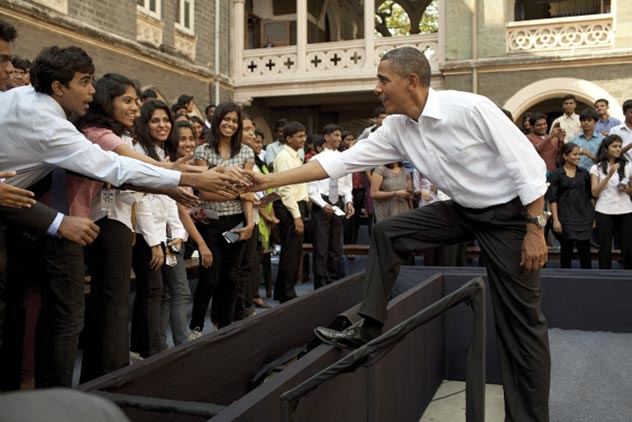
(Above): U.S. President Barack Obama greets students following a town hall meeting at St. Xavier College in Mumbai, Nov. 7. [Photo: Pete Souza | White House]
It will, of course, be foolish for India to get carried away by high words of praise by an American president keen to please a constituency, given the bulk of Indian population that exists in penury and poverty.
Obama’s time in India were spent at South Mumbai and New Delhi, two of the most developed and expensive Indian locations. Impoverished states such as Bihar and Uttar Pradesh tell a totally different story.
However, there is no denying that the 300-350 million odd Indians who have done well and continue to prosper, form a formidable base that will only multiply in terms of income and demand creation.
The Indian government, flush with revenues, is also a big client for inter-country deals and treaties such as in nuclear energy and defense.
Yet the Americans will be no easy clients. As Washington had pushed for ending of the international moratorium on nuclear trade on India by signing a civil nuclear deal with the South Asian nation in 2008, it expects American firms to win a chunk of the reactor contracts, a matter touched by Obama.
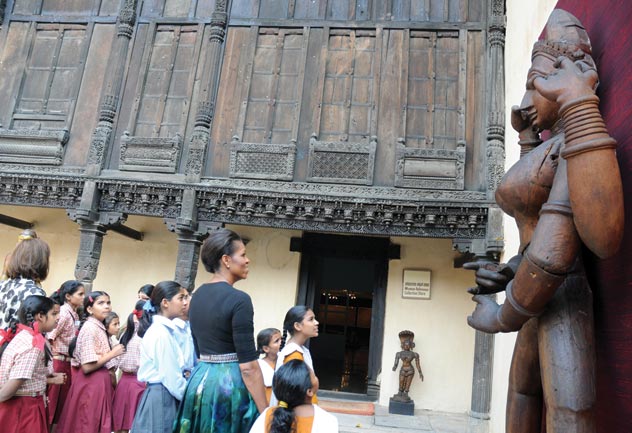
(Above): U.S. First Lady Michelle Obama visits the Craft Museum at Pragati Maidan in New Delhi, Nov. 8. [Photo: PRESS INFORMATION BUREAU]
In keeping with U.S. wishes and ahead of Obama’s visit, India signed the Convention on Supplementary Compensation for Nuclear Damage at the International Atomic Energy Agency office in Vienna, thereby setting the stage for full fledged nuclear commerce with American firms.
The prospects of being wooed by the global superpower, given its military, diplomatic and economic clout, flatter India. However, Indian policymakers need to keep a level head and weigh their options carefully so that India is not eventually shortchanged.
|